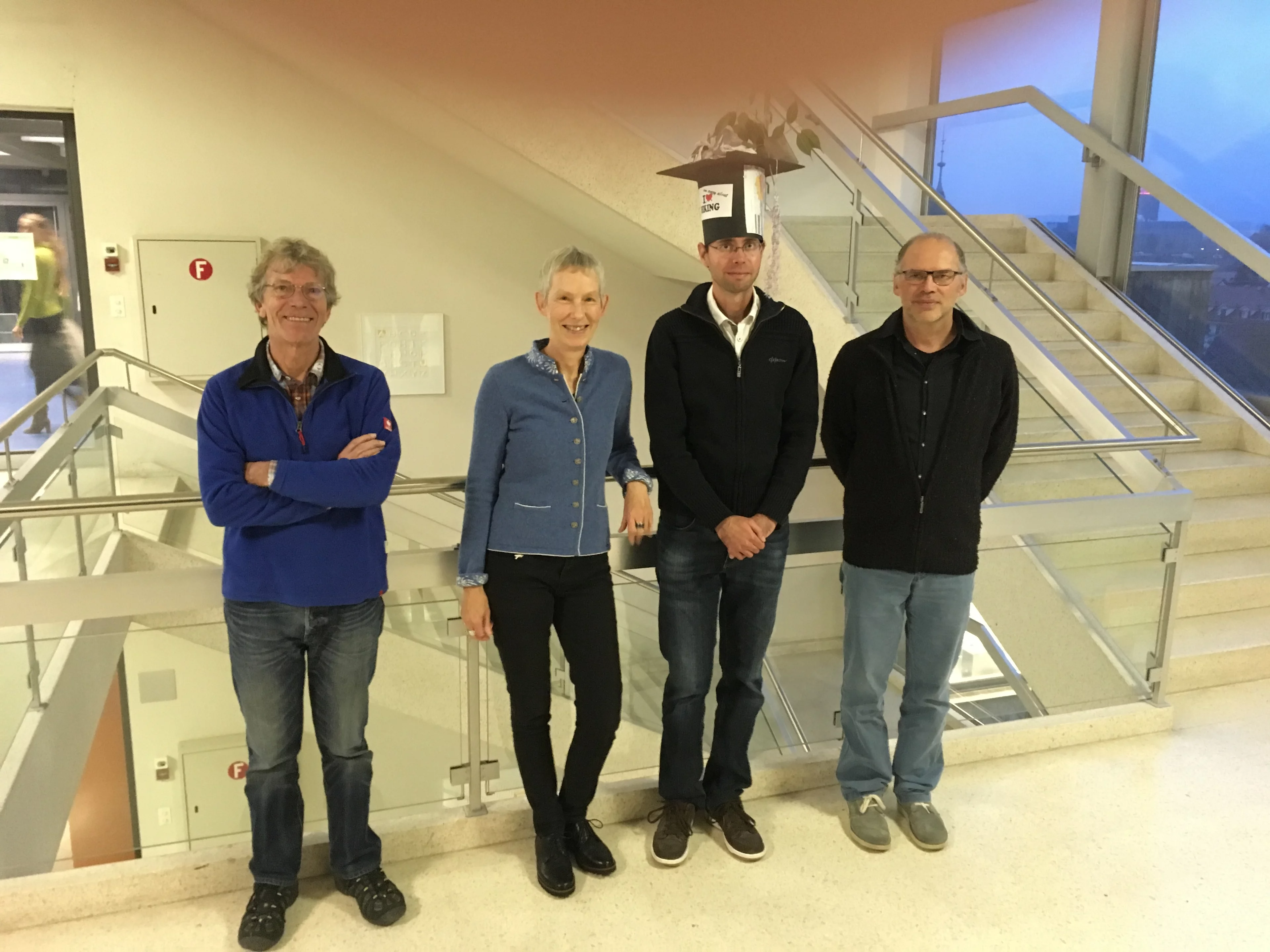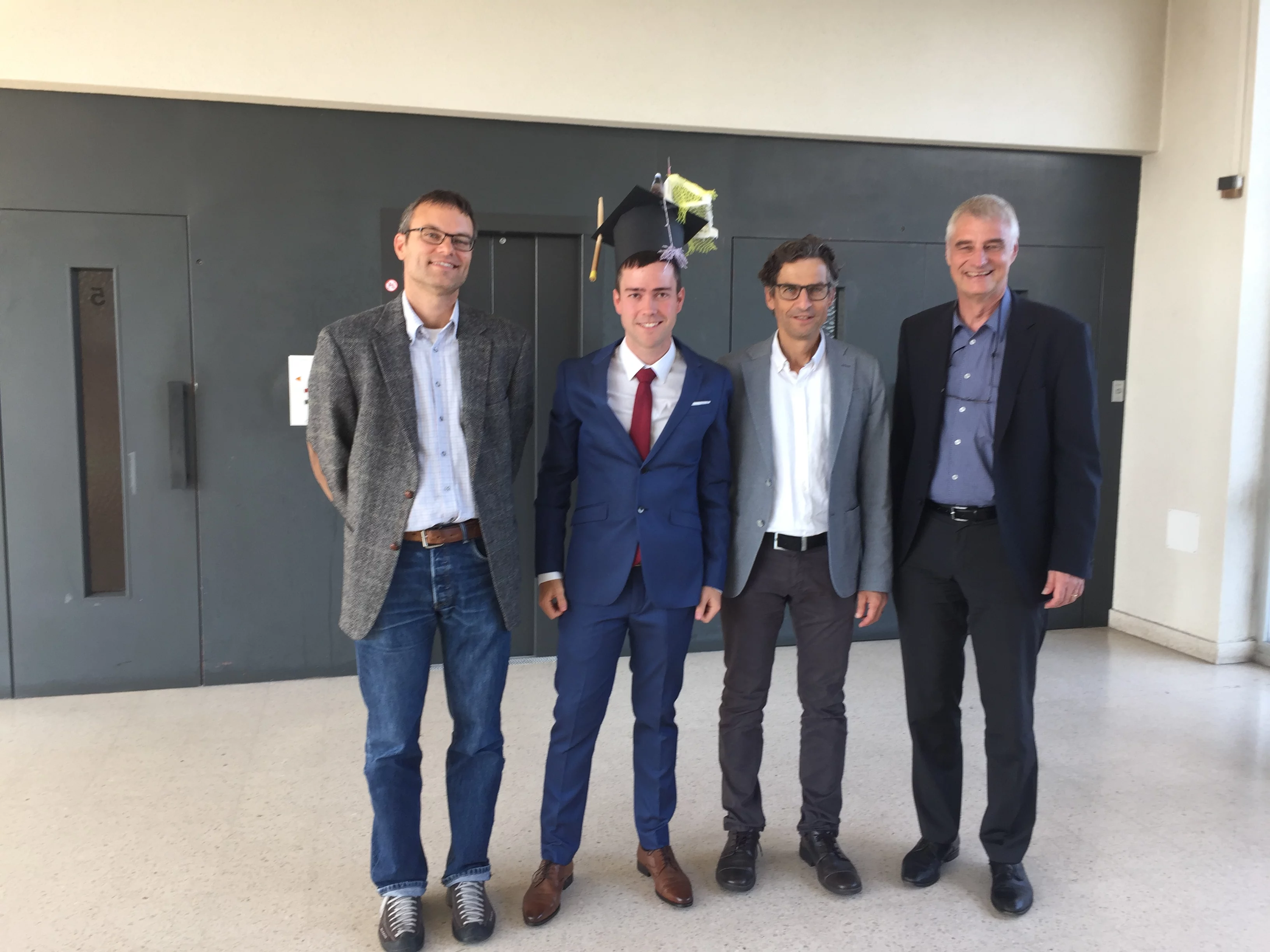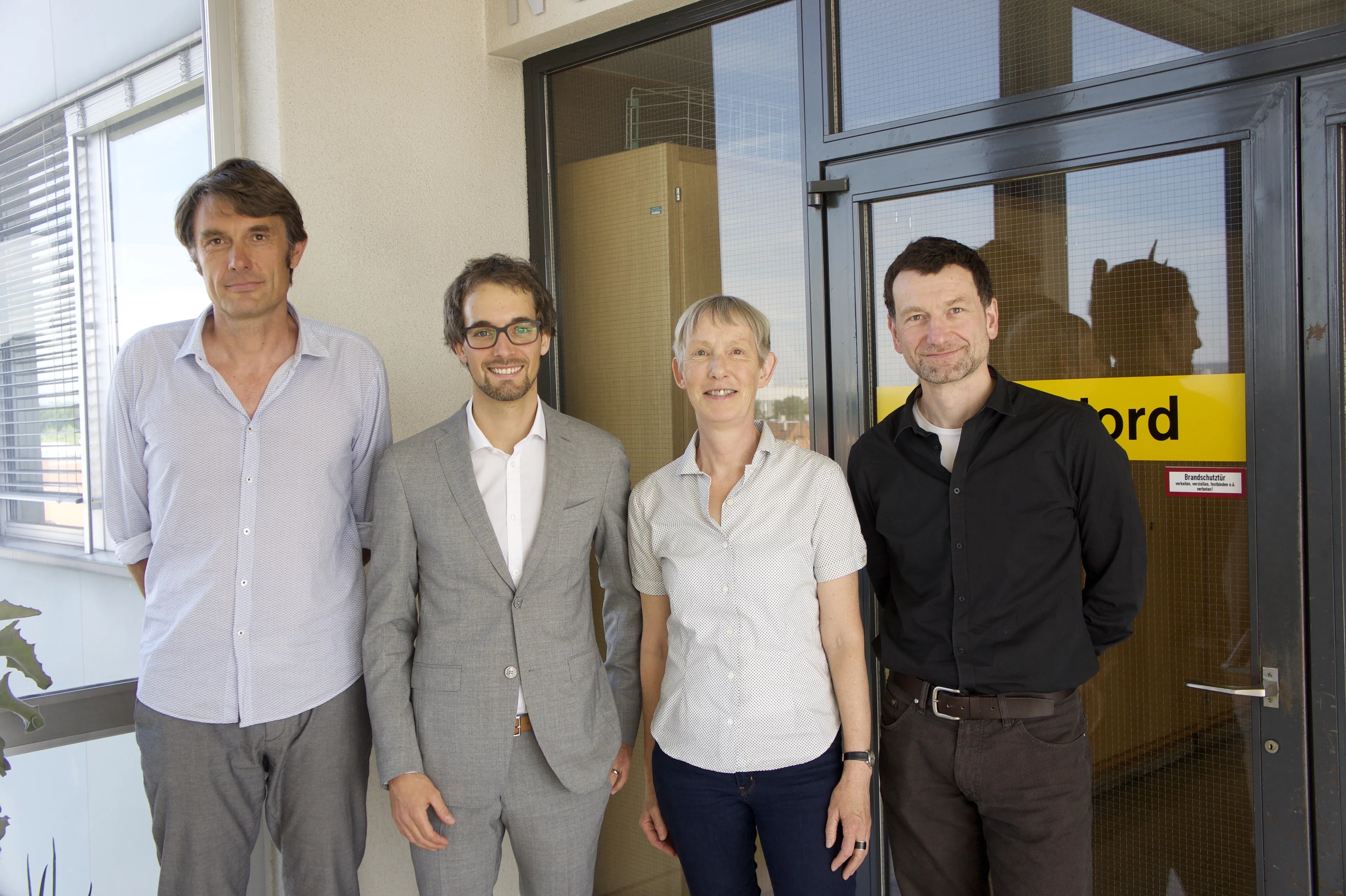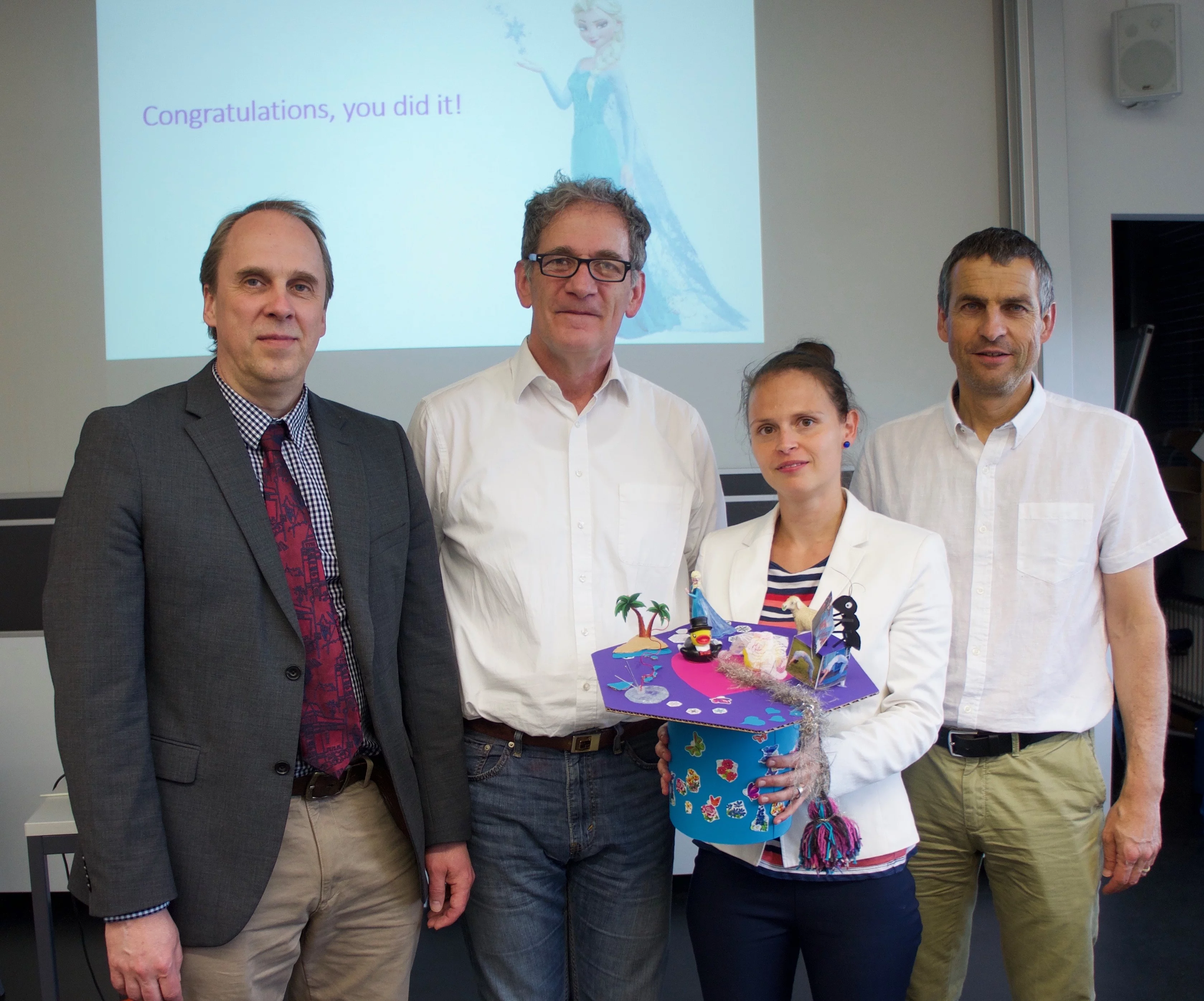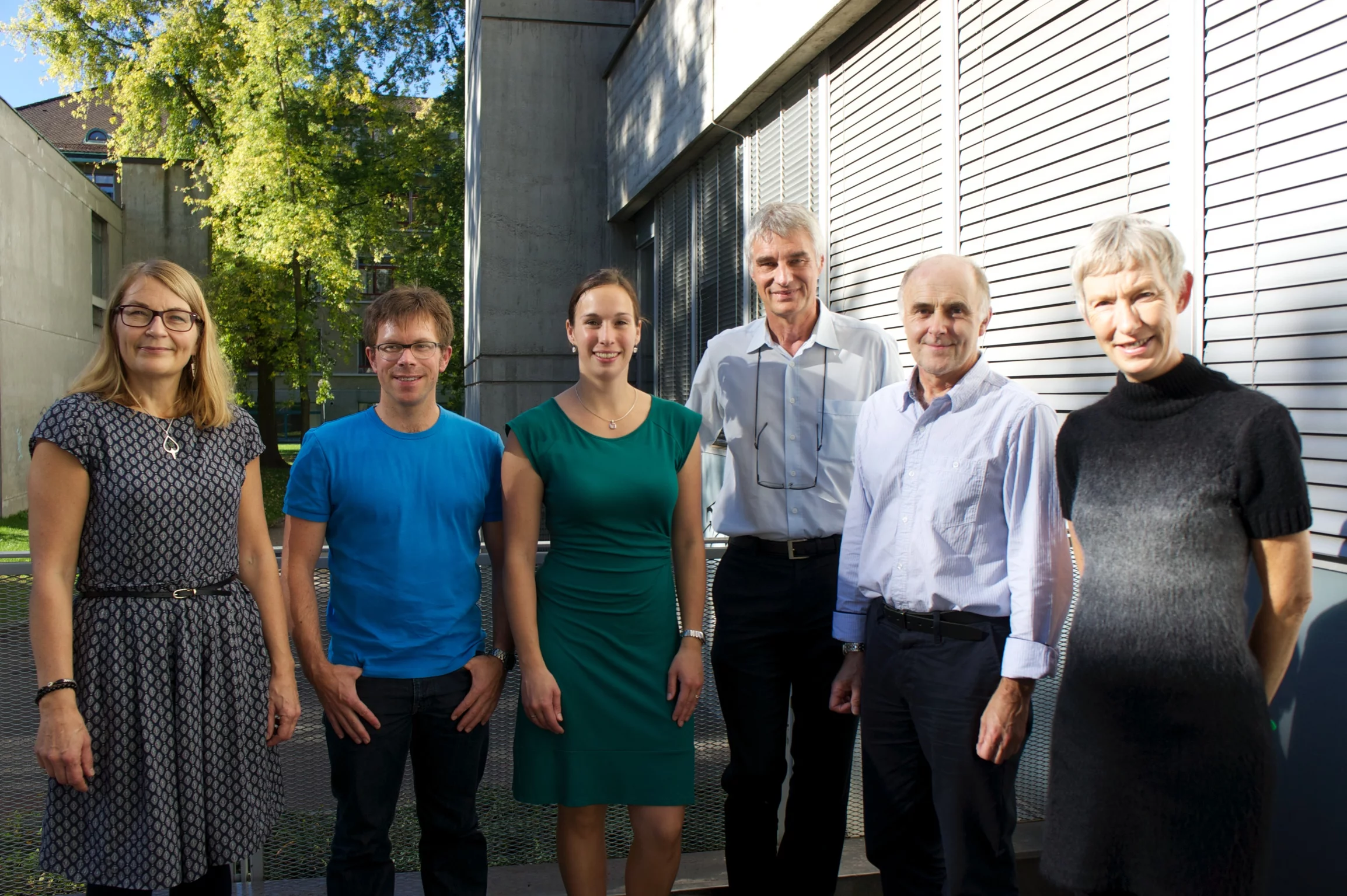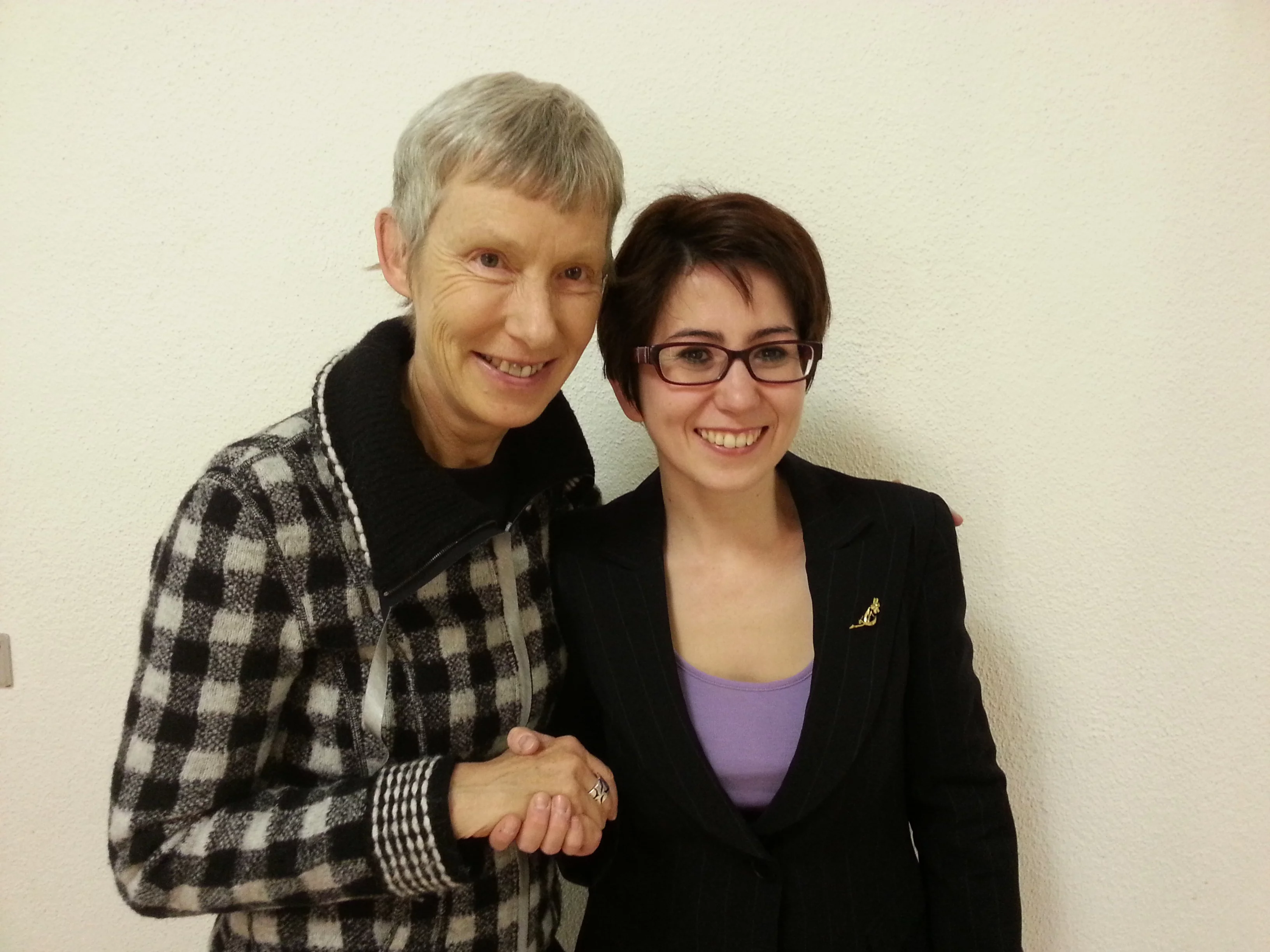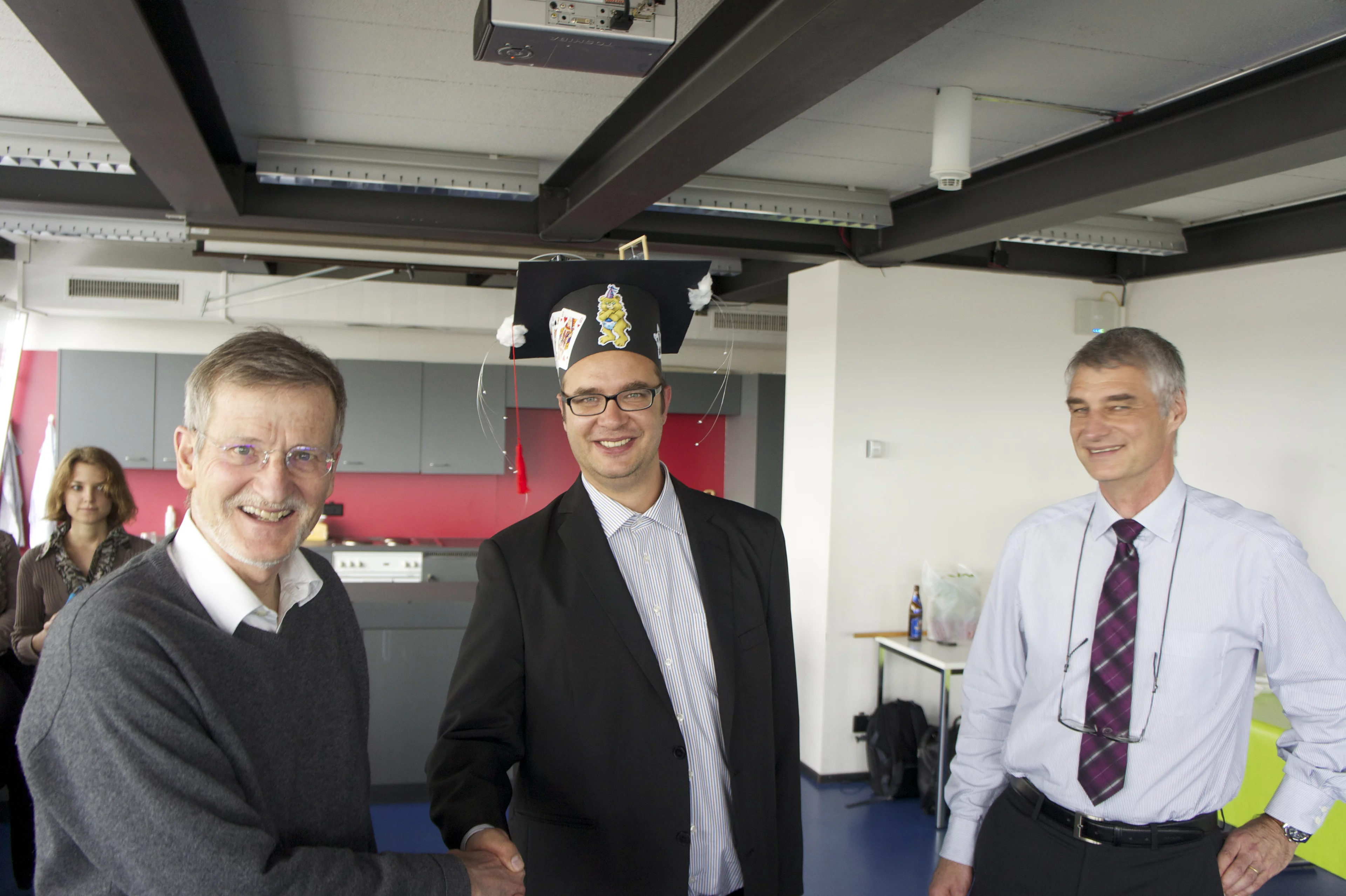at the Laboratory of Environmental Chemistry (LUC) since 2013
26 September 2022
Jérôme Gabathuler
The thickness of the quasi-liquid layer on ice and its interaction with atmospheric gases as seen by X-ray absorption and photoelectron spectroscopies, ETH Zurich (2018 - 2022)
Ice is ubiquitous in the environment and plays a role in atmospheric chemical cycles, which impacts the environment and human health. Therefore, it is important to understand the mechanism by which ice interacts with the air. The commonly accepted picture is the presence of a quasi-liquid layer (QLL) on the surface of the ice that increases in thickness with increasing temperature or with increasing exposure to soluble trace gases.
X-ray excited electron spectroscopy, X-ray photoelectron spectroscopy (XPS), and partial electron yield X-ray absorption spectroscopy (PEY-XAS) have been used to obtain a quantitative surface sensitive elemental and chemical composition analysis, and insights into the structure of the hydrogen bonding (HB) network in the ice lattice close to the surface, respectively.
In this thesis, the thickness of the QLL on pure ice was investigated as a function of temperature. In comparison to previous experiments, a refined analysis was developed considering scattering of electrons in the condensed and the gas phase. The results reveal that the QLL is of the order of ∼2nm close to the melting point.
In terms of exposure to trace gases, the adsorption of hexylamine (HA) on ice was studied to complement the large literature that is available about the adsorption of acids on ice. A saturated monolayer appears to be present already at a partial pressure of 2 × 10−5 mbar, and more than half of the HA molecules are protonated. The PEY-XAS data revealed that the adsorbed HA on ice at -20°C reveal a HB network similar to that of pure ice at -1°C, comparable to strong acids.
Thesis: Download pdf
Project Leader and Contact: Markus Ammann
07 April 2022
Shuzhen Chen
Thesis: Download pdf
Project Leader and Contact: Markus Ammann
Multiphase kinetics and chemistry at halide solution-air interfaces, ETH Zurich (2016 - 2022)
Oxidation of halides at the aqueous solution–air interface initiates the release of gas-phase halogen compounds, representing 50% of the chemical sink of ozone in the global troposphere. Halide solution-air interfaces are ubiquitously present because about 71% of the Earth’s surface is covered by seawater that contains large amounts of chloride and bromide. In addition, these are furthermore emitted to the atmosphere in the form of sea spray aerosol and are therefore also transported over long distances over the continents. Recently, with the development of differentially pumped electrostatic lens systems, liquid-jet X-ray photoelectron spectroscopy (XPS) allows us to directly probe the aqueous solution–air interface at the molecular level in the presence of trace gases. In this project, we use liquid-jet XPS at the Swiss Light Source in conjunction with kinetic experiments to study: the analysis of the surface propensity of bromide and its oxidation products hypobromite and bromate, and of organic surfactants with differently charged headgroups, both individually and in combination with bromide using liquid jet XPS. Finally, the impacts of surfactants on oxidation kinetics are assessed in laboratory-based flow tube experiments. The aim is to support future assessments of halogen chemistry on atmospheric oxidation capacity and climate.
Publications:
-
Gladich I, Chen S, Yang H, Boucly A, Winter B, van Bokhoven JA, et al.
Liquid-gas interface of iron aqueous solutions and Fenton reagents
Journal of Physical Chemistry Letters. 2022; 13(13): 2994-3001. https://doi.org/10.1021/acs.jpclett.2c00380
DORA PSI -
Gladich I, Chen S, Yang H, Boucly A, Winter B, Van Bokhoven JA, et al.
Reply to "comment on 'liquid-gas interface of iron aqueous solutions and fenton reagents'"
Journal of Physical Chemistry Letters. 2022; 13(29): 6681-6682. https://doi.org/10.1021/acs.jpclett.2c01391
DORA PSI -
Kong X, Dou J, Chen S, Wang B, Wu Z
同步辐射技术在大气科学领域的研究进展. Progress of synchrotron-based research on atmospheric science
Progress in Chemistry. 2022; 34(4): 963-972. https://doi.org/10.7536/PC210438
DORA PSI -
Chen S, Artiglia L, Orlando F, Edebeli J, Kong X, Yang H, et al.
Impact of tetrabutylammonium on the oxidation of bromide by ozone
ACS Earth and Space Chemistry. 2021; 5(11): 3008-3021. https://doi.org/10.1021/acsearthspacechem.1c00233
DORA PSI -
Gladich I, Chen S, Vazdar M, Boucly A, Yang H, Ammann M, et al.
Surface propensity of aqueous atmospheric bromine at the liquid-gas interface
Journal of Physical Chemistry Letters. 2020; 11(9): 3422-3429. https://doi.org/10.1021/acs.jpclett.0c00633
DORA PSI -
Orlando F, Artiglia L, Yang H, Kong X, Roy K, Waldner A, et al.
Disordered adsorbed water layers on TiO2 nanoparticles under subsaturated humidity conditions at 235 K
Journal of Physical Chemistry Letters. 2019; 10(23): 7433-7438. https://doi.org/10.1021/acs.jpclett.9b02779
DORA PSI -
Artiglia L, Edebeli J, Orlando F, Chen S, Lee M-T, Corral Arroyo P, et al.
A surface-stabilized ozonide triggers bromide oxidation at the aqueous solution-vapour interface
Nature Communications. 2017; 8(1): 700 (8 pp.). https://doi.org/10.1038/s41467-017-00823-x
DORA PSI -
Lee M-T, Orlando F, Artiglia L, Chen S, Ammann M
Chemical composition and properties of the liquid-vapor interface of aqueous C1 to C4 monofunctional acid and alcohol solutions
Journal of Physical Chemistry A. 2016; 120(49): 9749-9758. https://doi.org/10.1021/acs.jpca.6b09261
DORA PSI
10 November 2021
Huanyu Yang
Thesis: Download pdf
Project Leader and Contact: Markus Ammann
Hydrogen bonding structure of water at interfaces relevant for ice nucleation, ETH Zurich (2017 - 2021)
This work reveals the water HB structure at different interfaces is the result of a complex interplay of interactions of water molecules among each other and with the solid substrates or organic molecules on a molecular level. These findings have significant atmospheric relevance, as the studied solid materials and organic molecules are considered important ice nucleating materials originating from both anthropogenic and biogenic nature, and their changing abundance and composition is implicated in climate change. This work will spur future investigations towards interfacial water molecules on other materials or aqueous solutions in an atmospheric but also other scientific contexts.
Publications:
- Ordered hydrogen bonding structure of water molecules adsorbed on silver iodide particles under subsaturated conditions
J. Phys. Chem. C 125(21), 11628-11635 (2021).DOI: 10.1021/acs.jpcc.1c01767
- Disordered adsorbed water layers on TiO2 nanoparticles under subsaturated humidity conditions at 235 K
J. Phys. Chem. Lett. 10(23), 7433-7438 (2019).DOI: 10.1021/acs.jpclett.9b0277
02 June 2020
Ling Fang
Thesis: Download pdf
Project Leader and Contact: Margit Schwikowski]
Radiocarbon analysis of dissolved organic carbon from ice cores, Uni Bern (2016-2020)
This thesis provided the first comprehensive evaluation of the great potential of applying radiocarbon analysis of the dissolved organic carbon (DOC) fraction in ice cores at different time scale. Before large-scale human activities (biomass burning, fossil fuel burning, land use etc.), DO14C analysis was used to determine the age of the ice. After the industrialization, radiocarbon analysis can be used for investigating the anthropogenic perturbation to carbonaceous aerosols. Aerosols have very different regional scale distribution due to their short atmospheric lifetime and the uneven distribution of emissions sources. In this thesis, the first complete high-resolution carbonaceous aerosol record with the corresponding fossil and non-fossil contributions was reconstructed from the Fiescherhorn glacier ice core (3900 m asl., Swiss Alps). The total carbonaceous aerosol increased by a factor of three at the end of the 20th century compared to the pre-industrial background. Fossil fuel combustion contributed up to ~32% of the increase. Element carbon (EC) had highest values in the first half of the 20th century, to a large extend caused by fossil fuel emissions. In contrast, Organic carbon (OC) showed a strong increasing trend since 1940s, mostly of non-fossil origin, due to the enhancement of SOA formation.
Publications:
- Extraction of dissolved organic carbon from glacier ice for radiocarbon analyses
Radiocarbon 61(3), 681-694 (2019).DOI: 10.1017/RDC.2019.36
- A comprehensive nontarget analysis for the molecular reconstruction of organic aerosol composition from glacier ice cores
Environ. Sci. Technol 53, 21, 12565-12575 (2019).DOI: 10.1021/acs.est.9b03091
- Radiocarbon dating of alpine ice cores with the dissolved organic carbon (DOC) fraction
RThe Cryosphere, in review (2020).DOI: 10.5194/tc-2020-234
29 October 2018
Dimitri Osmont
Reconstruction of forest fires through chemical analysis of black carbon in ice cores from high- alpine glaciers, Uni Bern (2015-2018)
Abstract Wildfires are an important contributor to the global carbon budget. Complex relationships exist between fires, climate and humans as they are interconnected by an ensemble of feedbacks. Fires influence the climate by emitting greenhouse gases and aerosols and can have a significant influence on regional landscapes and vegetation cover. On the contrary, climate is a major driver of fire activity. Human societies have always made use of fire for their activities (cooking, heating, agriculture) but at the same time feared it and tried to control it. In the context of the current global warming, fires are expected to increase in duration, size and number in many regions of the world. In order to accurately simulate future fire evolution, it is necessary to understand past mechanisms between fires, climate and humans and put them into the current context. For this purpose, paleoclimate archives are used to reconstruct paleofire activity. So far, most of the reconstructions have been derived from charcoal analyses from lake sediment cores. Worldwide compilations revealed a trend called the “broken fire hockey stick”: while fire activity was following the trends of its main drivers, namely temperature and population density until 1870 AD, i.e. a decrease until 1750 AD and an strong increase until 1870 AD, a decoupling was observed since 1870 AD, as temperatures and population density kept on rising whereas fire activity dropped, possibly because of increasing anthropogenic pressure due to fire suppression and land-use changes. However, this hypothesis remains controversial as charcoal records are characterized by a high dating uncertainty in their most recent part and can only provide information about local fire activity, meaning that they have to be compiled to extract a global signal. The initial charcoal compilation was strongly biased in number towards European and North American regions and neglected many regions with elevated current levels of biomass burning (Tropics, boreal Siberia). Ice cores also have the potential to reconstruct paleofire activity. They present intrinsic advantages compared to lake-sediment charcoal records, such as a better controlled chronology and a much larger catchment area, from regional to continental scales. So far, few paleofire reconstructions have been performed by means of ice cores, most of them originating from polar regions. In these studies, a large variety of biomass burning proxies has been used: black carbon (BC), ammonium, light organic acids, molecular fire tracers (levoglucosan, vanillic acid, etc...), all of them having intrinsic advantages and limitations due to their different behaviors and sensitivities towards emission, transport, deposition and post-deposition processes.. This PhD thesis is part of the inter-disciplinary PaleoFire project, whose aim is to reconstruct paleofire history from high-mountain ice cores through a multi-proxy approach using refractory black carbon (rBC) and charcoal analyses combined with atmospheric modeling and remote sensing of fires, in order to test the “broken fire hockey stick” hypothesis.
Thesis: Download pdf
Project Leader and Contact: Margit Schwikowski]
Publications:
- Ice records provide new insights into climatic vulnerability of Central Asian forest and steppe communities
Global and Planetary Change 169, 188-201 (2018).DOI: https://doi.org/10.1016/j.gloplacha.2018.07.010
- 19th century glacier retreat in the Alps preceded the emergence of industrial black carbon deposition on high-alpine glaciers
The Cryosphere 12, 3311-3331 (2018).DOI: 10.5194/tc-12-3311-2018
16 October 2018
Jacinta Edebeli
Multiphase Chemical Reactivity in Cold Regions, ETH Zürich (2015-2018)
Abstract The cryosphere plays an important role in Earth’s energy balance and in the cycling of compounds in the environment, serves as an important archive of the Earth’s past climate and atmospheric composition. In addition, the cryosphere is a reactive matrix, and multiphase chemical reactions in these cold regions of Earth impact the atmospheric composition. When reactive losses lead to significant loss of compounds trapped in the snow, interpretation of ice core records of these compounds become difficult. From a chemical perspective, the cryospheric matrices such as surface snow, sea ice, and clouds are complex mixtures, where the reactions can proceed in a number of distinct compartments. To understand cryospheric chemistry in this full complexity, reaction rates of key reactants have to be known in their compartments. These compartments include the air-ice interface, aerosol deposits, and brine in micropockets. This thesis investigated chemistry with relevance to cold regions in the world especially the polar regions using bromide oxidation by ozone in well-defined laboratory experiments. Given the importance of halogens in Polar boundary layer chemistry, their reactions at the air-ice interface and in aerosol have been investigated in great detail. Therefore, this system was chosen here as a model system to investigate chemistry in the snow compartments with a major focus on increasing complexity in laboratory samples to mimic conditions in the environment better. The general interest in halogen chemistry stems from its essential impact on the oxidative capacity of polar atmospheres and and the role of halide on the fate of compounds in the atmosphere due to formation of reactive halogen species (RHS). Of particular importance is the impact on the fate of gas phase mercury, which gets oxidized by RHS leading to increased deposition of mercury with implications for ecosystem and human health. This thesis contributes to the better understanding of chemistry in snow and cold aerosol, and in particular, to ozone reaction with bromide: the interfacial process and the temperature dependence of this reaction, and the partitioning of bromide between the surface and the bulk of the ice during snow metamorphism.
Thesis: Download PDF
Funding and Project: Swiss National Science Foundation grant 155999
Project Leader and Contact: Thorsten Bartels-Rausch surface chemistry research group
Publications:
- New tools for atmospheric chemistry: general discussion
Faraday Discussions 200, 663-691 (2017).DOI: 10.1039/C7FD90041D
- A surface-stabilized ozonide triggers bromide oxidation at the aqueous solution-vapour interface
Nature Communications 8, 700 (2017).DOI: 10.1038/s41467-017-00823-x
28 September 2018
Pablo Corral Arroyo
Impacts of indirect photochemistry of Brown Carbon and iron carboxylate complexes on gas and aerosol chemistry, University of Bern (2014-2018)
Abstract Atmospheric aerosol particles suffer transformations during their residence time in the atmosphere (10 days on average). These transformations, known as aerosol aging, include physical transfor- mations or chemical processes and are intensely influenced by the physical properties of the particles such as viscosity, diffusivity or absorption. The understanding of these transformations is essential to evaluate their impact on climate, air quality and health. Photochemistry may start aging processes by the presence of chromophores in aerosol particles that act as photocatalysts inducing oxidation of non-absorbing molecules, known as indirect photochemistry. Even though initial photochemical excitation occurs ubiquitously over the whole particle, the diffusion of the reactants plays a key role in the chemical processes that follow. The scope of this thesis is to assess the role of indirect photochemical aerosol aging in the life cycle of aqueous atmospheric aerosol particles including radical production, halogen activation and chemical evolution, to understand the links with the microphysical properties and to provide a sound basis for integration of these processes in atmospheric models. We aim to find out whether indirect photochemical aerosol aging processes are affected by transport limitations and changing photochemical regimes in viscous aqueous particles and to what degree indirect photochemical processes feed back to the microphysical properties. The two light absorbing species families we are interested in are iron complexes, specifically Fe(III) citrate and aromatic ketone photosensitizers, which are brown carbon (BrC) substances, such as imidazole- 2-carboxaldehyde (IC) among others. Iron (Fe(III)) carboxylate complexes absorb light below about 500 nm which leads to reduction of iron to Fe(II) and oxidation of the carboxylate ligands, which initiates the degradation of carboxylate ligands producing a broad spectrum of compounds, including OVOCs. This process represents an important sink of organic acids in the troposphere20. Fe(III) carboxylate complexes are well-known to be photochemically active and they trigger Fenton-like reactions which are the dominant source of OH radicals in aerosol particles21,22. Aromatic carbonyl photosensitizers absorb above 300 nm and form triplet excited states which initiate redox processes with other compounds by H atom abstraction from organics or electron transfer triggering organic and HOx radical chemistry. Photosensitized processes provide an important contribution to condensed phase radical production and aerosol aging. Measurements of HO2 radical release from films containing BrC chromophores and citric acid, which is the matrix and main H atom donor, are performed as a function of chromophore content, relative humidity (RH), gas phase oxygen content and thickness. Experiments with additional donors such syringol, shikimic acid or halides are performed. In addition, iodine release, photochemically induced by IC, is measured as a function of time. We assess the contribution of photochemistry to radical budgets and redox activity, compare the impact on the gas phase versus internal cycling and consumption, as well as the photochemically induced halogen activation and release, and determine the effect of diffusion and water content on these processes. Aerosol growth induced by IC photochemistry by reactive uptake of an organic H atom donor is also assessed. The evolution of carbon functional groups is followed in single particles containing Fe(III) citrate and citric acid exposed to humidity and oxygen under irradiation by scanning transmission X-ray microscopy (STXM) experiments. Non-volatile organic compounds produced by Fe(III) citrate photochemistry are analyzed with high pressure liquid chromatography mass spectromety (HPLC-MS) of the extracts of irradiated samples of iron citrate. STXM and HPLC-MS measurements provide us with information about the chemical evolution and the efficiency of functionalization or oligomerization. By means of OVOCs release measured in SOAwith and without iron under irradiation the impact in the gas phase and to the mass loss in SOA due to photochemistry will be assessed.
Thesis: Download pdf
Funding: Swiss National Science Foundation grant 163074
Project Leader and Contact: Markus Ammann
Publications:
- Heterogeneous photochemistry of imidazole-2-carboxaldehyde: HO2 radical formation and aerosol growth
Atmospheric Chemistry and Physics 16, 11823-11836 (2016).DOI: 10.5194/acp-16-11823-2016
- A surface-stabilized ozonide triggers bromide oxidation at the aqueous solution-vapour interface
Nature Communications 8, 700 (2017).DOI: 10.1038/s41467-017-00823-x
- Particle-Phase Photosensitized Radical Production and Aerosol Aging
Environmental Science and Technology (2018).DOI: 10.1021/acs.est.8b00329
5 December 2017
Anna Dal Farra
Effect of light-absorbing impurities on the albedo of the Alpine glacier Plaine Morte, University of Bern (2012-2017)
Abstract The incoming solar radiation is a crucial component of the Earth’s energy balance. As the Sun's emissions reach the Earth’s surface, a certain percentage of that energy is absorbed by Earth. Albedo is defined as the ratio of the radiant flux reflected from a unit surface area into the whole hemisphere to the incident radiant flux of hemispherical angular extent. It is a dimensionless value that ranges from 0 to 1. The total Earth albedo is currently estimated around 0.3. Each type of surface present on Earth contributes differently to its total albedo, however no natural occurring surface has a higher albedo than fresh snow, which can be as high as 0.90. Snow- covered areas therefore play a key role in the Earth’s energy balance. The duration and extension of a snowpack can influence the amount of radiation absorbed by the Earth surface, hence the global temperature. Albedo is relevant both at a large global scale and at a smaller scale, when considering systems like glaciers. For glaciers, albedo is influenced by the ageing of the snow, which affects snow grain size. The older it is the larger are the snow crystals and consequently the lower the albedo. Also the presence of liquid water lowers albedo by increasing the snow crystal size and the penetration depth of the radiation. Further decrease of albedo is caused by the exposure of underlying bare ice on glaciers, and by the presence of light- absorbing impurities (LAI). LAI darken the snow/ice surface, resulting in greater absorption of solar energy, consequently increasing surface temperature. In glaciers with high LAI deposition and enrichment, LAI can be a larger driver of snow/ice melt than temperature. The types of LAI present on a glacier depend on the local conditions. Principally they can be divided into three categories: black carbon (BC), organic matter and mineral dust. BC is a product of incompletely combusted gas phase condensates of biomass or fossil fuels; with natural and anthropogenic sources, in the case of biomass. The organic matter can be the living biota whose habitat is the glacier itself or humic substances, which are formed by the decomposition of algae and bacteria, and possess very dark colouring. Mineral dust sources can be natural, like desert regions and local outcrops or anthropogenic as construction areas and agricultural sites. Most studies have focused on one or two of these types of LAI, with a special emphasis on anthropogenic BC. The majority of these studies have considered the LAI’s influence on snow and not on ice. Therefore a knowledge gap exists for LAI identification and quantification on a snow free glacier surface considering all involved LAI. The aim of this research project was therefore to characterize the LAI present on a glacier, to identify their main classes and their optical properties and finally to quantify their contribution to the albedo lowering. The final task was to upscale the quantification of the LAI effect by using high spatially resolved reflectance data collected remotely with the Airborne Prism Experiment (APEX) sensing flight.
Thesis: Download pdf
Funding: University of Berne and Paul Scherrer Institut
Project Leader and Contact: Margit Schwikowski
Publications:
- Spectral signatures of submicron scale light-absorbing impurities in snow and ice using hyperspectral microscopy
Journal of Glaciology 1-10 (2018).DOI: 10.1017/jog.2018.29
2 June 2017
Johannes Schindler
An Extraction System for Radiocarbon Microanalysis of Dissolved Organic Carbon in Glacier Ice, University of Bern (2012-2016)
Abstract Radiocarbon is especially powerful for dating alpine glaciers because its half-life of 5730 years suitably allows it to cover the typical age range of these archives. Most important, glacier ice does contain minute amounts of carbon. While macrofossils can only be found by coincidence, organic aerosols deposited on the glacier offer the best source of contemporary carbon in glacier ice. Despite a large part of its chemical composition being unknown, organic carbon found in an ice sample can be operationally classified into a particulate fraction (POC) and a dissolved fraction (DOC). Radiocarbon dating of POC has proven to be very successful and is a routine application by now. The major limitation of this technique is the low POC concentration found especially in pre-industrial and polar ice samples. Therefore, the DOC fraction promises even better suitability for dating thanks to its by a factor of 5 to 10 higher concentrations. Nevertheless, a straightforward analysis of DOC is hampered by its vulnerability to contamination. DOC consists in large part of mono- and dicarboxylic acids compounds that can easily be taken up from the surrounding gas phase during sample preparation or which are dissolved from surfaces in contact with the liquid sample. Hence it is vital to ensure ultra-clean sample preparation with a low and stable procedural blank for reliable radiocarbon analysis of DOC from glacier ice. In this work, we developed an extraction system for DOC from glacier ice samples. To meet the requirements of ultra-clean and efficient carbon extraction, the complete sample treatment is performed in inert gas conditions and only dedicated materials are chosen for the individual components of the setup.
Thesis: Download pdf
Funding: University of Berne and Paul Scherrer Institut
Project Leader and Contact: Margit Schwikowski
12 May 2017
Astrid Waldner
Molecular level picture of the interaction between ice and trace gases, ETH Zurich (2014-2017)
Abstract Ice and trace gases are ubiquitous in the environment and can interact with each other, both in the atmosphere and on the ground. The interactions can have impact on geochemical cycles, the environment, and human health. However, a detailed and commonly accepted picture of the underlying molecular level processes is still missing. Ambient pressure X-ray spectroscopy (APXS) is ideally suited to investigate ice-trace gas interactions due to its chemical selectivity and surface sensitivity in the nanometer range. It enables analysis of how ice and trace gases interact. Unlike most other techniques used to look at ice-trace gas interactions, APXS is a direct method for investigating chemical composition profiles and changes in the structure of the hydrogen-bonding network of the uppermost nanometers of the ice. Within the frame of this thesis, I analysed the molecular level interaction between ice and three different trace gases. These gases include propionaldehyde, formic acid (HCOOH), and hydrogen chloride (HCl). The aim was to investigate the chemical distribution of the trace gases in the ice and the effect of the acidity of a trace gas on ice-trace gas interactions.The presented analyses may contribute to a revised picture of the molecular level process of the ice-trace gas interactions facilitating improved atmosphere and climate models.
Thesis: Download pdf
Funding: Swiss National Science Foundation grant 149629
Project Leader and Contact: Thorsten Bartels-Rausch
Publications:
- The environmental photochemistry of oxide surfaces and the nature of frozen salt solutions: A new in situ XPS approach
Topics in Catalysis 59, 591-604 (2016).DOI: 10.1007/s11244-015-0515-5
- Coexistence of Physisorbed and Solvated HCl at Warm Ice Surfaces
Journal of Physical Chemistry Letters 4757-4762 (2017).DOI: 10.1021/acs.jpclett.7b01573
- Pre-melting and the adsorption of formic acid at the air–ice interface at 253 K as seen by NEXAFS and XPS
Physical Chemistry Chemical Physics 20, 24408-24417 (2018).DOI: 10.1039/C8CP03621G
30 October 2015
Ming-Tao Lee
The Role of Organics in the Chemical Composition and Reactivity at the Surface of Halide Solutions Relevant for Marine Aerosol or Ocean Surface Water, University of Bern (2010-2014)
Abstract Oceans cover approximately 71% of the Earth's surface and are playing a key role in climate regulation via a large number of physical and chemical processes. Seawater constitutes a complex aqueous electrolyte with an average salt concentration of 0.5 molar, the dominant ionic solutes being Na+ and Cl– (followed by Mg2+, SO4–, Br–, and I– to mention a few). While present in much lower concentrations, organic materials are highly important in affecting the surface-specific chemistry of sea-water aqueous systems, given their high surface propensity. The overall aim of the present project is to develop a detailed insight into the behavior of sodium halide species at mixed organic/aqueous liquid surfaces. Specific goals include: Firstly, establishing an understanding of the interplay of sodium halide ions and organic solutes at the air-water interface at a molecular level. The primary approach to achieve these goals will be to perform synchrotron-based studies using near-ambient pressure X-ray photoelectron spectroscopy, at the Swiss Light Source. Secondly, laboratory experiments related to the structure and heterogeneous reactivity of aqueous halide solutions in the context of atmospheric chemistry in marine environments and further investigations on how such surface reactions are affected by the presence of various relevant organic compounds.
Thesis: Download pdf
Funding: Swiss National Science Foundation grant 149492
Project Leader and Contact: Markus Ammann
Publications:
- A new endstation at the Swiss Light Source for ultraviolet photoelectron spectroscopy, X-ray photoelectron spectroscopy, and X-ray absorption spectroscopy measurements of liquid solutions
Review of Scientific Instruments 84, 073904-073908 (2013).DOI: 10.1063/1.4812786
- Liquid–vapor interface of formic acid solutions in salt water: A comparison of macroscopic surface tension and microscopic in situ X-ray photoelectron spectroscopy measurements
Journal of Physical Chemistry C 140807164344005 (2014).DOI: 10.1021/jp5056039
- Ion spatial distributions at the air– and vacuum – aqueous K2CO3 interfaces
Journal of Physical Chemistry C 119, 4976-4982 (2015).DOI: 10.1021/acs.jpcc.5b00257
- Quantitative depth profiling of Ce3+ in Pt/CeO2 by in situ high-energy XPS in a hydrogen atmosphere
Physical Chemistry Chemical Physics 17, 5078-5083 (2015).DOI: 10.1039/C4CP05643D
- The competition between organics and bromide at the aqueous solution – air interface as seen from ozone uptake kinetics and X-ray photoelectron spectroscopy
Journal of Physical Chemistry A (2015).DOI: 10.1021/jp510707s
- The environmental photochemistry of oxide surfaces and the nature of frozen salt solutions: A new in situ XPS approach
Topics in Catalysis 59, 591-604 (2016).DOI: 10.1007/s11244-015-0515-5
- A surface-stabilized ozonide triggers bromide oxidation at the aqueous solution-vapour interface
Nature Communications 8, 700 (2017).DOI: 10.1038/s41467-017-00823-x
16 December 2014
Goran Grzinic
The Multiphase Chemical Kinetics of Dinitrogen Pentoxide with Aerosol Particles, University of Bern (2010-2014)
Abstract Dinitrogen pentoxide (N2O5) is an important reactive intermediate in the nighttime chemistry of nitrogen oxides (NOx). As one of the major NOx sinks, it plays an important role in the regulation of the oxidative capacity of the atmosphere. We have used the 13N radioactive isotope tracer technique to synthesize 13N labelled N2O5 for the first time and we have assembled an experimental system for the study of uptake kinetics of N2O5 on aerosol particles. A computer model of the involved gas phase chemistry was created to help optimize the production of N2O5. The experimental set-up was successfully tested and routine production of 13N2O5 in the ppb range was established. We have studied the uptake of N2O5 on citric acid aerosol over an atmospherically relevant humidity range (17-70% RH). Citric acid was used as a proxy for highly oxidized organic species present in ambient organic aerosol. Our results have shown that reactivity in the above mentioned humidity interval varies roughly an order of magnitude, with uptake going from approximately 3x10-4 to 3x10-3. This is significantly lower than similar organic compounds. We have investigated the impact of viscosity and diffusivity on citric acid reactivity and have postulated that this factor might be responsible for discrepancies in reactivity observed between field measurements and predictions based on laboratory results. The ‘nitrate effect’ present in nitrate containing aerosol was investigated using the 13N radioactive tracer technique. The particular properties of the 13N tracer method have allowed probing the chemical mechanism of N2O5 heterogeneous hydrolysis and obtain insight into some of the individual steps of the mechanism. In particular we have determined that the bulk accommodation coefficient, αb, is equal to or greater than 0.4, which is significantly larger than previously thought. This will likely have a strong impact on the modelling of N2O5 uptake on aerosol particles. Additionally, it helps explaining some situations where uptake measured in ambient aerosol is higher than expected, based on laboratory studies.
Thesis: Download pdf
Funding: Swiss National Science Foundation grant 130175
Project Leader and Contact: Markus Ammann
Publications:
- Production and use of 13N labeled N2O5 to determine gas–aerosol interaction kinetics
Radiochimica Acta 102, 1025 (2014).DOI: 10.1515/ract-2014-2244
- The influence of physical state on shikimic acid ozonolysis: A case for in situ microspectroscopy
Atmospheric Chemistry and Physics 14, 10761-10772 (2014).DOI: 10.5194/acp-14-10761-2014
- Viscosity controls humidity dependence of N2O5 uptake to citric acid aerosol
Atmospheric Chemistry and Physics 15, 13615-13625 (2015).DOI: 10.5194/acp-15-13615-2015
- Efficient bulk mass accommodation and dissociation of N2O5 in neutral aqueous aerosol
Atmospheric Chemistry and Physics 17, 6493-6502 (2017).DOI: 10.5194/acp-17-6493-2017
18 November 2014
Sarah Steimer
Interplay of Diffusivity and Reactivity in Organic Aerosol Aging, ETH Zürich (2010-2014)
Abstract Atmospheric aerosol particles influence climate, affect human health, and transport condensed materials over long distances. During their lifetime in the atmosphere, those particles undergo transformation through chemical reactions. This aging process in turn affects their properties, such as hygroscopicity and absorptivity. It has been shown that particles which contain organic matter can adopt an amorphous solid state in the atmosphere. This will slow down the mass transport within the bulk, which could decrease reactivity by limiting reactant supply. This thesis deals with the question of how exactly changes in physical state and thereby diffusivity influence chemical reactions in atmospheric particles. To investigate the influence of physical state on reactivity of organic matter in particles, we studied the kinetics of the shikimic acid ozonolysis in depth, using three different experimental techniques. We used electrodynamic balance measurements of single, levitated shikimic acid particles to investigate the physical state of shikimic acid and obtain parametrizations for density, concentration and water diffusion coefficients as a function of relative humidity. We found that shikimic acid particles do not crystallize at low humidity, but become amorphous solids instead and that water diffusivity decreases from 1.9 · 10−9 m2 s−1 to about 1 · 10−16 m2 s−1 in a dry shikimic acid particle compared to the dilute aqueous solution. With this knowledge, we then investigated the influence of physical state on the shikimic acid ozonolysis.
We used scanning transmission X-ray microscopy combined with near-edge X- ray absorption fine structure spectroscopy to follow the shikimic acid degradation. This was the first time that this technique was successfully applied to measure the reaction of an atmospherically relevant material in situ. Decreasing humidity clearly correlated with decreasing reactivity. We saw a dependence of the reaction rate on particle size at low humidity, but did not observe a gradient in shikimic acid at any measured humidity. From this we concluded that the system can best be described by the analytical expression for reacto-diffusion limited uptake at all humidities below the highest humidity considered (83%). The second order rate constant of the ozonolysis was determined for the first time; its value is (3±1.8)·103 Lmol−1s−1. To extend the range of accessible kinetic regimes, we also studied the same reaction by monitoring the ozone consumption in a coated wall flow tube under varying environmental conditions. Both the general trend in correlation of humidity and re- activity, and the obtained second order rate constant of 1.5 · 103 L mol−1 s−1 are in good agreement with the results from the X-ray microscopy experiments. We found that also in this study, reacto-diffusive limitation best describes the up- take for the majority of the time at all humidities below the highest (92 %) when the resistor model is used for data analysis. However, the resistor model approach showed clear deficiencies in describing the uptake on long timescales and at low humidities. Fitting the experimental data with a kinetic flux model indicated that limitation in mass transport of shikimic acid might be responsible for some of these discrepancies. While the general trend of reactivity with relative humidity was captured well, none of the fits managed to correctly reproduce all features of the measured uptake. Further improvements are clearly needed and the current results from the model output should not be taken as final. With this work, we showed that a multi-technique approach is a clear benefit when dealing with complicated questions such as the dependence of reactivity on bulk diffusivity. In particular sophisticated models, such as the kinetic flux model we used to evaluate the flow tube data, profit from the different constraints provided by the different experiments to reduce arbitrariness of the results.
Thesis: Download pdf
Funding: Paul Scherrer Institute, ETH Zurich, Universität Bern, EU FP7 project PEGASOS
Project Leader and Contact: Markus Ammann
Publications:
- The influence of physical state on shikimic acid ozonolysis: A case for in situ microspectroscopy
Atmospheric Chemistry and Physics 14, 10761-10772 (2014).DOI: 10.5194/acp-14-10761-2014
- Shikimic acid ozonolysis kinetics of the transition from liquid aqueous solution to highly viscous glass
Physical Chemistry Chemical Physics 17, 31101-31109 (2015).DOI: 10.1039/c5cp04544d
- Electrodynamic balance measurements of thermodynamic, kinetic, and optical aerosol properties inaccessible to bulk methods
Atmospheric Measurement Techniques 8, 2397-2408 (2015).DOI: 10.5194/amt-8-2397-2015
- Ozone uptake on glassy, semi-solid and liquid organic matter and the role of reactive oxygen intermediates in atmospheric aerosol chemistry
Physical Chemistry Chemical Physics (2016).DOI: 10.1039/C6CP00634E
- Heterogeneous photochemistry of imidazole-2-carboxaldehyde: HO2 radical formation and aerosol growth
Atmospheric Chemistry and Physics 16, 11823-11836 (2016).DOI: 10.5194/acp-16-11823-2016
- Fatty Acid Surfactant Photochemistry Results in New Particle Formation
Scientific Reports 7, 12693 (2017).DOI: 10.1038/s41598-017-12601-2
17 October 2014
Isabel Wendl
High resolution records of black carbon and other aerosol constituents from the Lomonosovfonna 2009 ice core, University of Bern (2010-2014)
Abstract Black carbon (BC) is one of the short-lived atmospheric constituents whose radiative forcing is not yet fully understood and quantified. It has recently gained attention in the climate discussion because BC mitigation is expected to result in a climate effect within the next few decades, thus much earlier than that following from CO2 reduction. BC is a by-product of the incomplete combustion of biomass and fossil fuels that affects climate due to its light-absorbing properties. It has a direct warming effect in the atmosphere as well as an indirect effect once deposited on snow and ice. Deposited BC reduces the surface albedo which results in more absorption of the incoming solar radiation and thus in accelerated melting of snow and ice. This is of particular importance to the Polar Regions that comprise vast areas of snow-and ice-covered surfaces. The Arctic is already among the regions that are most affected by climate change because climate effects there are amplified. Over the past 100 years, Arctic temperatures have increased at almost twice the global average rate, with an increase in annual average surface air temperatures of 2-3°C in Alaska and Siberia from 1954 to 2003. This is accompanied by an earlier onset of the spring melt, a lengthening of the melt season, changes in the mass balance of the Greenland ice sheet, and a reduced sea ice extent. BC data from the Arctic are sparse and the existing global climate models often underestimate the effects in the Arctic. In order to understand today’s role of BC for the Arctic, climate information on past BC concentrations is needed. Instrumental observations cover only the most recent years and studies on Arctic snow extend back only several decades. Thus, natural archives, such as ice cores, provide an invaluable source of information on temperature, moisture, and atmospheric composition that extend beyond instrumental observations. Ice core research in the Arctic has so far mainly focused on the large ice sheet of Greenland. However, the high-altitude Greenland sites are affected by pollution from the low latitudes, which is contrary to the low-altitude sites outside of Greenland that are partly influenced by pollution sources located in the high latitudes. In order to get a more complete picture, it is also important to gain palaeo-climate information from sites outside of Greenland that have often been neglected because they are affected by seasonal melt. In this work, the ice core from Lomonosovfonna, Svalbard, drilled in 2009 (Lomo09), was analysed for BC and other atmospheric constituents in order to reconstruct the climate and environmental history of a low-altitude Arctic site. Because Lomonosovfonna has been proven to be less affected by melt, the atmospheric signal is better preserved than at other Arctic sites.
The Lomo09 ice core was dated by applying a multiple parameter approach. This included detection of reference horizons, annual layer counting based on the pronounced seasonality of delta 18O and Na+ concentration, nuclear dating with 210Pb, and a simple glacier flow model. This resulted in a robust chronology assigning the ice at the depth of 149.5 m to the year 1222. The core was sampled at high resolution (3-4 cm) so that even for the oldest ice annual resolution was obtained.
Thesis: Download pdf
Funding: Paul Scherrer Institut, University of Bern, and the Norwegian Polar Institute
Project Leader and Contact: Margit Schwikowski
Publications:
- Optimized method for black carbon analysis in ice and snow using the single particle soot photometer
Atmospheric Measurement Techniques 7, 2667-2681 (2014).DOI: 10.5194/amt-7-2667-2014
- 800-year ice-core record of nitrogen deposition in Svalbard linked to ocean productivity and biogenic emissions
Atmospheric Chemistry and Physics 15, 7287-7300 (2015).DOI: 10.5194/acp-15-7287-2015
24 September 2014
Pavlina Pavlova
Accelerated release of persistent organic pollutants from alpine glaciers, University of Bern (2010-2014)
Abstract Persistent organic pollutants (POPs) represent a group of anthropogenic compounds, including industrial chemicals, pesticides, as well as unintentional by-products of combustion processes and chemical reactions, which were released in the environment in the 20th century. Because of their toxicity and bioaccumulation potential, production and use of POPs was regulated with the Stockholm convention in 2004. These organic chemicals are characterized with persistence, volatility and lipophilicity, which determine their distribution in the environment. Substances of interest for the current study include polychlorinated biphenyls (PCBs; plasticizers, insulating and cooling liquid, etc.), dichlorodiphenyltrichloroethane and by-products (DDTs; insecticide for malaria control) and hexachlorocyclohexane (HCH; pesticide) and hexachlorobenzene (HCB; fungicide and combustion by-product). Although, POPs are no longer produced, they are still present in remote areas, far away from their initial sources. Because of the specific meteorology in mountains including low temperatures, high wind speed and high precipitation rates, POPs are enriched in high altitudes, despite of the remoteness. Glaciers represent climate and atmospheric composition archives in mountain ranges. When meteorology and topographic characteristics allow annual snow to accumulate over several years it transforms gradually to firn and finally to glacier ice. Under the force of gravity, the ice flows downwards to elevations with higher temperatures, where loss due to melting dominates over accumulation. The net gain or loss of ice mass on a glacier defines its mass balance. Since glaciers accumulate impurities together with snow, they represent not only archives, but also sinks of pollutants in the environment. Recent studies have shown, that accelerated melting of glaciers results in increased release rates of legacy pollutants into proglacial lakes. In the present project we investigate POPs regarding their deposition on, incorporation into, transport within, and release from temperate Alpine glaciers. To do so, we were challenged by the development of novel methods for dating temperate ice cores and the analysis of POPs in ice.
Thesis: Download pdf
Funding: Swiss National Science Foundation grant 130083 and grant 149835
Project Leader and Contact: Margit Schwikowski
Publications:
- Polychlorinated biphenyls in glaciers. 1. Deposition history from an Alpine ice core
Environmental Science and Technology 48, 7842-7848 (2014).DOI: 10.1021/es5017922
- Trace analysis of hydrophobic micropollutants in aqueous samples using capillary traps
Chemosphere 106, 51-56 (2014).DOI: 10.1016/j.chemosphere.2013.12.092
- Polychlorinated biphenyls in glaciers. 2. Model results of deposition and incorporation processes
Environmental Science and Technology 48, 7849-7857 (2014).DOI: 10.1021/es501793h
- Polychlorinated biphenyls in a temperate Alpine glacier: 1. Effect of percolating meltwater on their distribution in glacier ice
Environmental Science and Technology 49, 14085-14091 (2015).DOI: 10.1021/acs.est.5b03303
- Polychlorinated biphenyls in a temperate Alpine glacier: 2. Model results of chemical fate processes
Environmental Science and Technology 49, 14092-14100 (2015).DOI: 10.1021/acs.est.5b03304
- A temperate alpine glacier as a reservoir of polychlorinated biphenyls: Model results of incorporation, transport, and release
Environmental Science and Technology 50, 5572-5579 (2016).DOI: 10.1021/acs.est.5b05886
- A Temperate Alpine Glacier as a Reservoir of Polychlorinated Biphenyls: Model Results of Incorporation, Transport, and Release
Environmental Science and Technology 50, 5572-5579 (2016).DOI: 10.1021/acs.est.5b05886
- Legacy organochlorine pollutants in glacial watersheds: a review
Environmental Science: Processes & Impacts 19, 1474-1483 (2017).DOI: 10.1039/C7EM00393E
16 December 2013
Isabella Mariani
Water stable isotopes in Alpine ice cores as proxies for temperature and atmospheric circulation, University of Bern (2009-2013)
Abstract Water stable isotope ratios and net snow accumulation in ice cores are commonly interpreted as temperature or precipitation proxies. However, only in a few cases a direct calibration with instrumental data has been attempted. Taking advantage of the dense network of observations in the European Alpine region, in this PhD study the relationship of the annually and seasonally resolved proxy data from two highly-resolved ice cores was rigorously tested, comparing the proxies with local temperature and precipitation. The analysis focused on the most recent decades, where the highest amount and quality of meteorological data are available and the ice core dating uncertainty is minimal. The two ice cores were from the Fiescherhorn glacier in the Northern Alps (3900 m a.s.l.) and Grenzgletscher in the Southern Alps (4200 m a.s.l.). Due to the orographic barrier, the two flanks of the Alpine chain are affected by distinct patterns of precipitation. The different location of the two glaciers therefore offered a unique opportunity to test if such a specific setting is reflected in the proxy data.
Thesis: Download pdf
Funding: NCCR Climate
Project Leader and Contact: Margit Schwikowski analytical chemistry research group
Publications:
- Temperature and precipitation signal in two Alpine ice cores over the period 1961- 2001
Clim. Past Discuss. 8, 5867-5891 (2012).DOI: 10.5194/cpd-8-5867-2012
19 September 2013
Pierre-Alain Herren
Ice core based climate reconstruction from the Mongolian Altai, University of Bern (2009-2013)
Abstract Climate change has become a serious challenge to society in past decades. Changes in atmospheric conditions combined with sea level rise are expected to affect changes in economic wealth, modify the distribution of the earth’s most fertile land, and induce major migration of populations. Future climate scenarios still suffer large uncertain- ties. This is due to disagreement in climate models results, uncertainties in 21st century greenhouse gas emissions and discrepancy in paleoclimate reconstructions used to calibrate climate models. Nevertheless, model runs and observation clearly suggest that 20th century warming is human induced and can be attributed to the additional forcing of anthropogenic emissions. However, climate change has strong regional expression. More and more paleoclimate reconstructions aim to capture regional signals in order to place these recent climate changes in a long-term context. Regional estimates of the Medieval Warm Period (MWP) are still insufficient mostly due to limited data prior the Little Ice Age (LIA) and poor regional coverage. In this study the region of interest is continental Asia, more specificly the Altai mountain range located between the Siberian forest and the deserts of Central Asia. In recent decades this part of the globe experienced enhanced warming. Together with the Arctic it belongs to most affected regions of cur- rent climate change. The internal climate variability of this part of Central Asia still lacks understanding. For example changes in the Siberian High intensity, located above the Altai during wintertime have been associated to Eurasian climate. Current Central Asian climate reconstructions are strongly biased towards tree-ring chronologies. The initial goals of this study was to extend paleoclimate records derived from the Belukha ice core located on the north slope of the Altai, and to test the identified correlation between solar forcing and temperature in the Altai region for a warm climate interval such as the MWP. Here we present the results of a newly collected ice core from the Tsambagarav massif located on the southern slope of the Altai. A strong north-west to south-east precipitation gradient in the Altai suggest longer climate archives in the Mongolian Altai. The new record was assumed to provide additional regional paleoclimate records for improved understanding of the regional climate. The dating of the Tsambagarav ice core allowed studying Holocene glacier fluctuations and reconstruction of accumulation rates. Biogenic species measured in the ice core reflect temperature changes of the Siberian forests. The Tsambagarav paleoclimate records combined with climate reconstructions of the Belukha ice core, drilled during summer 2001 and located 350 km north-west of the Tsambagarav massif, enabled to investigate the spatial representativeness of the proxies.
Thesis: Download pdf
Funding: Swiss National Science Foundation grant 119743 and grant 134564
Project Leader and Contact: Margit Schwikowski analytical chemistry research group
Publications:
- The onset of Neoglaciation 6000 years ago in western Mongolia revealed by an ice core from the Tsambagarav mountain range
Quaternary Science Reviews 69, 59-68 (2013).DOI: 10.1016/j.quascirev.2013.02.025
- A continuous ice-core Be-10 record from Mongolian mid-latitudes: Influences of solar variability and local climate
Earth and Planetary Science Letters 437, 47-56 (2016).DOI: 10.1016/j.epsl.2016.01.006
31 Mai 2013
Thomas Ulrich
Interactions of Peroxynitric Acid and Hydrogen Peroxide with Ice and the Envrionmental Implications, University of Bern (2009-2013)
Abstract Peroxynitric acid (HNO4) and hydrogen peroxide (H2O2) are important trace gases with strong links to the oxidative capacity of the troposphere. Their adsorption to ice and snow in the troposphere can lead to a scavenging of both trace gas species from the atmosphere. Also their adsorption on snow packs and ice on the ground affect the atmospheric chemistry of the overlaying boundary layer. In this thesis results of laboratory experiments are presented and discussed, investigating the uptake of HNO4 and H2O2 to ice. A new gas phase synthesis for HNO4 is presented. This gas phase synthesis comprises a purification step, consisting of a Ti(IV) denuder and a cooling trap. The synthesis was successfully tested in packed bed flow tub experiments with different nitrogen oxides, resulting in a partitioning from the gas phase towards the ice surface in the order of HNO3 >HNO4 = HNO2 > NO2. In a subsequent study, the new synthesis was used in coated wall flow tube experiments. For the first time ice adsorption measurements low in impurities were possible and the temperature dependence of the partition constant KLinC from gas phase to ice surface was derived. The temperature dependence follows a relation ship given by 3.74e-12 * exp(7098/T) [cm]. The results differ from a previous study, our results show a much lower reversible adsorption process on the ice surface. Uptake of HNO4 to ice was often compared to that of HNO3 in literature. Using the lower partition constant derived in this study a different adsorption behaviour of HNO4 as compared to HNO3 in upper tropospheric cirrus clouds becomes evident. The uptake of HNO4 to ice particles in those clouds only becomes important at lower temperatures. Below 220 K and with very dense clouds present less than 10 % of HNO4 is adsorbed on the ice particles. Considering snow on the ground, snow packs represent a sink for HNO4 due to the high specific surface area of ice there. Literature results of the second trace gas species investigated in this thesis, H2O2, differed three orders of magnitude considering partitioning towards the ice surface. The older studies investigated H2O2 uptake to ice on short time scales to smooth ice surfaces. The results presented here agree with the higher, more temperature dependent partitioning reported earlier. In addition it is shown in this thesis, that the uptake of H2O2 to ice also includes a long term uptake to the ice, which is beyond the surface adsorption process. The long term uptake agrees quantitatively with an older packed bed study. Our results in the coated wall flow tube experiments suggest a diffusion process into the smooth polycrystalline ice. The environmental relevance of this bulk uptake exceeds that of the surface adsorption process when the chemistry above snow packs is concerned. On a more fundamental approach on the uptake of trace gases to ice, grain boundaries in polycrystalline ice have been proposed as a major reservoir for the bulk uptake of trace gases. In the last part of this thesis the development of a new flow through reactor for grain boundary dependent uptake of trace gases is presented. With this reactor different types of ices, varying in a grain boundary content by a factor of five, can be produced. With this set-up the uptake of trace gases into grain boundaries could be disentangled from the uptake into the ice crystal in follow-up studies. Preliminary results with nitrous acid (HNO2) in the reactor are presented.
Thesis: Download pdf
Funding and Project: Swiss National Science Foundation grant 121857 and grant 140400
Project Leader and Contact: Thorsten Bartels-Rausch surface chemistry research group
Publications:
- A novel synthesis of the N-13 labelled atmospheric trace gas peroxynitric acid
Radiochimica Acta 99, 285-292 (2011).DOI: 10.1524/ract.2011.1830
- The adsorption of peroxynitric acid on ice between 230 K and 253 K
Atmospheric Chemistry and Physics 12, 1833-1845 (2012).DOI: 10.5194/acp-12-1833-2012


